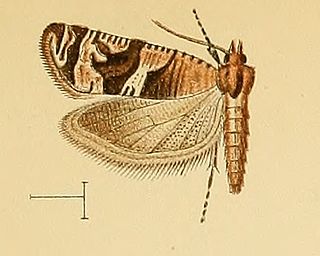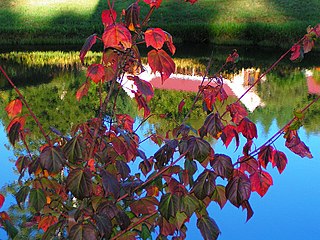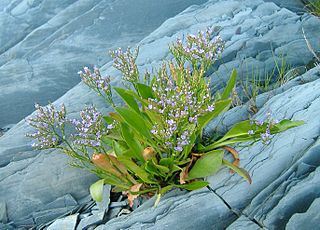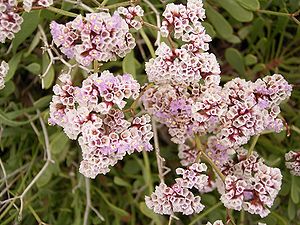Everlasting may refer to:

Plumbaginaceae is a family of flowering plants, with a cosmopolitan distribution. The family is sometimes referred to as the leadwort family or the plumbago family.

Limonium is a genus of 120 flowering plant species. Members are also known as sea-lavender, statice, caspia or marsh-rosemary. Despite their common names, species are not related to the lavenders or to rosemary. They are instead in Plumbaginaceae, the plumbago or leadwort family. The generic name is from the Latin līmōnion, used by Pliny for a wild plant and is ultimately derived from the Ancient Greek leimon.
Dacrydium pectinatum is a species of conifer in the family Podocarpaceae. It grows naturally in Hainan, Borneo, the Philippines and Sumatra.

Limonium binervosum, commonly known as rock sea-lavender, is an aggregate species in the family Plumbaginaceae.

Geastrum pectinatum is an inedible species of mushroom belonging to the earthstar family of fungi. Although young specimens are spherical, fruit body development involves the outer layer of tissue splitting open like a star into 7 to 10 pointed rays that eventually bend back to point downward, revealing a small – 1 to 2.5 cm broad – spore sac. The spore sac is supported by a small radially wrinkled stalk. There is a distinct conical opening (peristome) at the top of the spore sac that is up to 8 mm (0.3 in) long. It is commonly known as the beaked earthstar or the beret earthstar, in reference to the shape of the spore sac and its prominent, protruding peristome. The mass of spores and surrounding cells within the sac, the gleba, is dark-brown, and becomes powdery in mature specimens. Spores are spherical, measuring 4 to 6 micrometers in diameter, with warts on their surfaces. Although uncommon, Geastrum pectinatum has a cosmopolitan distribution, and has been collected in various locations in Europe, North and South America, Asia, Australia and Africa, where it grows on the ground in open woods. Like several other earthstars, crystals of calcium oxalate are found on G. pectinatum, and are thought to be involved in fruit body maturation.

Limonium perezii is a species of Limonium known by the common names Perez's sea lavender and seafoam statice. It is also known as simply statice, sea lavender or marsh rosemary. It is native to the coasts of the Canary Islands but are widely used in gardens throughout the world.
Acalyptris staticis is a moth of the family Nepticulidae. It is only known from the coast of Tenerife, but might also be present on the other Canary Islands and Morocco.
Polemonium pectinatum is a species of flowering plant in the phlox family known by the common names Washington Jacob's-ladder and Washington polemonium. It is endemic to the state of Washington in the United States, where it occurs in the Columbia Basin, including the Channeled Scablands and the Palouse.

Lobesia neptunia is a moth of the family Tortricidae. It is found on the Canary Islands and Madeira.

Acer pectinatum is an Asian species of maple. It is native to the Himalayas and nearby mountains in southwestern China, Myanmar, and the northeastern part of the Indian Subcontinent.
Limonium jovibarba is a species of flowering plants of the family Plumbaginaceae. The species is endemic to Cape Verde. It is listed as critically endangered by the IUCN. The species was named by Carl Ernst Otto Kunze in 1891. Its local name is carqueja, a name that may also refer to the related species Limonium brunneri and Limonium braunii.
Limonium brunneri is a species of flowering plants of the family Plumbaginaceae. The species is endemic to Cape Verde. It is listed as critically endangered by the IUCN. The species was named by Carl Ernst Otto Kunze in 1891. Its local name is carqueja, a name that may also refer to the related species Limonium braunii and Limonium jovibarba.
Limonium braunii is a species of flowering plants of the family Plumbaginaceae. The species is endemic to Cape Verde. It is listed as an endangered plant by the IUCN. The species was first described by the German Carl August Bolle as Statice braunii and was placed in the genus Limonium by the French Auguste Chevalier in 1935. Its local name is carqueja, a name that may also refer to the related species Limonium brunneri and Limonium jovibarba.
Statice limonium may refer to:

Limonium vulgare, called common sea-lavender, is a species of flowering plant in the genus Limonium native to the Azores, western Europe, and southwestern Sweden, and introduced elsewhere. A clumping perennial found in salt marshes and other maritime habitats, it is a probable species complex.

Limonium carolinianum, known variously as Carolina sealavender, canker root, ink root, marsh root, lavender thrift, American thrift, or seaside thrift, is a species of flowering plant native to the eastern shores of North America, from northern Mexico to Canada. It is a slow-growing perennial herb found in salt marshes and other maritime habitats. Its inflorescences are frequently harvested for use in cut flower arrangements.

Mesosphaerum is a genus of flowering plants in the family Lamiaceae, native to the New World Tropics and Subtropics. Two species, Mesosphaerum pectinatum and Mesosphaerum suaveolens, have been introduced to the Old World, with M. suaveolens found in the tropics of Africa, Asia and Australia.











